Have you ever dreamt of seeing the cherry blossoms flower along the Kyoto canals? And walk among the Torii as they turn red at sunset?
Have you ever dreamt of seeing the cherry blossoms flower along the Kyoto canals? And walk among the Torii as they turn red at sunset?
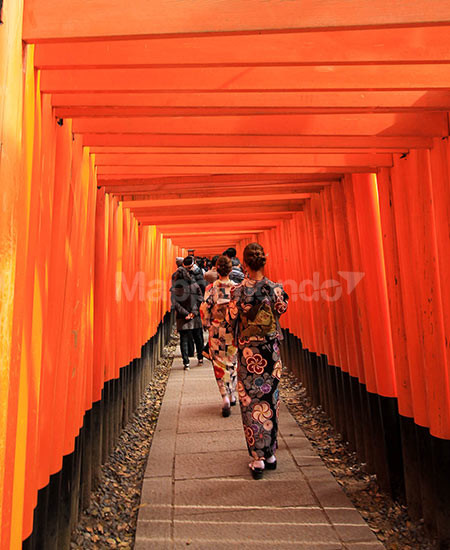
Like me you were probably raised on bread and Japanese cartoons, and those incomprehensible symbols that appeared between an episode of Candy Candy and one of Steel Jeeg, or between an episode of Sailor Moon and one of Dragon Ball.
Kiss me Licia (Aishite Knight) introduced us to the “real” Japan. The two male protagonists, Satomi with his purple hair and Mirko with his yellow and red hair, the colours of Roma football club, were the leaders of music band Bee Hive. What can you expect from two guys with these names and hair and a bee hive group? A swarm of screaming girls, dressed as Lolitas, ready to pull out their hair at their concerts. The two main characters were often seen walking through a deserted city…we’re talking about Tokyo: 35 million people!

The most colourful character was Marrabbio, the father of the protagonist, Licia, who dressed like a runaway. Marrabbio had a typical Japanese restaurant with two tables and four tatamis; with his eyes closed he would angrily cut the fish like a Samurai. Licia’s blue-haired little brother had a mouth of steel; he could gulp down Marrabbio’s smoking hot Ramen in just a few nanoseconds.
This was my first introduction to Japanese, how about that!
I bet that, like me, you tried to draw Manga characters at school, with the end result looking more like Picasso’s Guernica than a Japanese drawing.
Then I grew up and started dreaming with Lost in Translation, by Sofia Coppola, where its two main characters, Bob and Charlotte, fall in love at the Tokyo Park Hyatt, not in a humble Capsule Hotel!

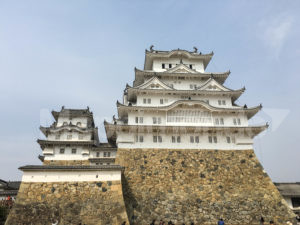
How can you not imagine yourself next to Tom Cruise in the final scene of The Last Samurai; in that castle, surrounded by peaceful hills in the middle of autumn!
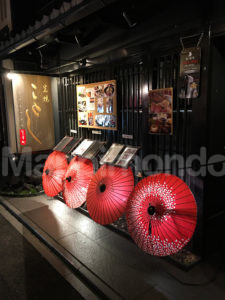
And Memoirs of a Geisha?
We’ve heard about the legendary Japanese sense of honour, or we’ve read about Japanese players who leave their changing rooms tidy during international sports competitions. But what are they like in their own home?
If, like Feuerbach said: “We are what we eat”, are the Japanese only sushi and sashimi?
Are they really that different from us?
I would say the time has come to go to Japan and see if they are as zen as their gardens and if sushi in Japan is like Carbonara Pasta in Rome; in other words, unique!
When? During the traditional Sakura time of year, when the cherry trees blossom, so I can admire the flowers, known as the Hanami.
The Hanami reminds us of how flighting life is; the cherry tree blossoms, its beautiful flowers bloom but the wind then blows them away.
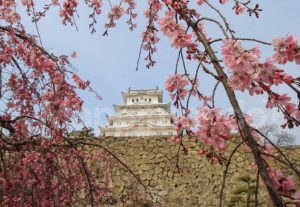
Quando? Durante il tradizionale periodo della Sakura, la mitica fioritura dei ciliegi, per ammirarne i fiori, ovvero l’Hanami.
L’hanami ci ricorda quanto la vita sia effimera: il fiore di ciliegio sboccia e fiorisce nella sua fragile bellezza, che il vento se lo porta via.
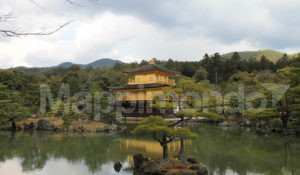
As well as describing my trip to Japan I would like to answer the questions I am asked most frequently:
- How expensive is Japan?
- Is it easy to organise a DIY trip to Japan?
- What documents do you need?
- Do I need to buy the Japan Rail Pass and can I take the Shinkansen?
- Where to stay in Japan?
- What is there to see in Japan?
HOW EXPENSIVE IS JAPAN?
You even pay for the air you breathe in Japan and that’s the absolute truth. My Lonely Planet guide says this isn’t true, that it’s a myth. Well, I don’t know; in about ten days I spent the same amount I spent in a month in Vietnam, Cambodia and Thailand.
I chose to go to Japan during the Hanami, and the cherry blossoms bloom between the end of March and April, which also coincides with my birthday; it was a present to myself.
If you decide to see Japan during the Hanami you must we aware that prices are noticeably higher; a bit like in August in Europe. A hotel that normally costs around 100 euros a day will set you back 300; the worst moment is when you see it and understand you’ve been robbed. And to make things worse: most of the photos you see around of cherry trees in bloom have had their saturation touched up. I thought I would be immerging myself in a bright pink landscape and I saw it was actually baby pink; still gorgeous though.

Japan is the destination of choice for many honeymoons; it is often combined with Fiji or French Polynesia. You can ask a travel agent to make the arrangements for you or you can create your own trip.
Japan has something for all pockets; of course, the more you spend the nicer your stay will be.
IS IT EASY TO ORGANISE A DAY TRIP TO JAPAN?
Yes! I’ll tell you what I did before arriving in Japan:
- I bought an Air China plane ticket with stopover in Peking, destination Tokyo. If you are planning your trip far enough in advance, I recommend a direct flight.
- I chose a hotel in Chiyoda, in the centre of Tokyo, as the city is huge and getting around can be a problem.
- I bought a week long Japan Rail Pass in Italy so I could move around by train.
- I booked a small apartment in Kyoto.
- I booked a hotel at Hiroshima station; it was in a great position.
WHAT DOCUMENTS DO YOU NEED?
You need a valid passport for Japan and we Italians don’t need a tourist visa; obviously this applies if going for a limited period of time and you are travelling purely as a tourist.
JAPAN RAIL PASS AND SHINKANSEN
If you want to travel round Japan you absolutely must buy the JAPAN RAIL PASS!
Before leaving for Japan I bought a weekly rail pass in a travel agent in Rome, but you can buy one online. However, this voucher must be exchanged in Japan in one of the JR offices, which you will find at the airport or train stations. They ask you to fill in a questionnaire and you choose the start date for your Pass. It sounds simple but I recommend you set off well in advance of your departure time as there’s a long queue and you first need to understand where to go.
SHINKANSEN
Careful! You cannot take the “Nozomi” and “Mizuho” Shinkansen, the fastest trains, but you can take the “Hikari” and “Sakura” ones. So, pay attention to which train is which as your ticket won’t be valid on some trains.
What can I say: they are spectacular! They’re like missiles shooting through the air.
Even though our high-speed trains are even faster, and it’s not something I made up, it says so online, their trains are impressive. The aerodynamic shape of Japanese trains is like something from outer space!
Booking your seat: obviously there are no seats available at any price, but I’m kindly told that there is a coach for passengers who haven’t booked. Once again: let’s go for it!
You absolutely have to find a seat as there’s no luggage section so it’s difficult to find a place for your bags.
On my journey from Tokyo to Kyoto I somehow manage to grab a seat, I place the biggest case in front of my legs and the others on top of me; my goal is to never get up!
An elderly woman gets one, she’s short with a curved spine. Nobody, and I mean nobody, got up to give her their seat. I had become a human suitcase, I was covered in luggage and I felt terrible, as I always give up my seat to those who need one. The passengers, all young, had no bags but nobody even asked her if she wanted to sit down. What happened to the legendary Japanese politeness? My goodness! They clean other people’s changing rooms; they bow to greet you I don’t know how many times and then they don’t get up to let an old lady sit down?
I spend the train journey looking out of the window; I can’t believe it: cement is all you see from when you leave Tokyo station to when you arrive. At one point you can make out Mount Fuji. It’s prettier in the paintings I have at home!
WHERE TO STAY IN JAPAN?
There is so much choice:
HOTEL
Hotels deserve a special mention in my travel memoirs. Obviously, we would all like to go to the Park Hyatt in Shinjuku Park Tower and enjoy the view of Tokyo all the way to Mount Fuji and, if you can, go ahead!
However, we then have to face reality and the prices and accommodation offered by the city’s hotels. And this is the thing about Japan! Rooms measure on average 10-12 square metres, if you’re lucky.

The hotel I chose in Tokyo is situated in Chiyoda; it’s decent but basic. The room, however, was designed for Smurfs; 12 square metres. You basically have a double bed, a sort of table and your suitcases will take up all the available walking space.
“Please bring your own wings as you will be required to fly from the bathroom to your bed” is what must be written using ideograms somewhere in the hotel.
The bathroom is incredible; there’s everything in a tiny space. The toilet ought to come with instructions; it’s all electronic, buttons everywhere. I’m almost scared to press them in case Mazinga’s photon ray bursts out at me! Only in Japan could they have invented such a toilet!
CAPSULE HOTEL
As we were raised on manga and ninja cartoons, we know that the Japanese are absolute geniuses and have discovered that you can sleep in a lot less than 10 square metres! Enter the Capsule Hotels. Welcome to your nocturnal crypt!
You have a bedroom with capsules for men and another for women. Basically, you don’t get on to your bed, but you slide into these long box-like pods fitted into the wall and meant for one person. They are placed one above the other; you climb a ladder to get to them and they come with some mod cons.
You will have already left your suitcases in a locker outside the capsule room, you leave your slippers on the floor, and up you go for your Tutankhamen-like sarcophagus experience!
LOVE HOTEL
Are you ready? They’re fantastic! They even made a film about them. If those beds could talk, imagine the tales they could tell. So, you book your room – but be careful! You will either see the writing “Rest”, which means the room is rented by the hour, or “Stay” where you can spend the night. If you think you will be staying the night you arrive at 9 pm and leave in the morning.
Basically, if you’re only staying one night, you’ll be fine! Otherwise you’ll be like a refugee walking around with your suitcases. For me, and my many suitcases, this option is unfeasible for more than one night.
RYOKAN
Japanese style hotels built in the typical local style. There’s a tatami and you sleep on a futon, which you pick up in the morning and put away in a cupboard. You live following their essential lifestyle and you need to wear a nice kimono and wooden slippers. They aren’t exactly free but at least you feel you are living like the locals.
I think futons are Ikea’s most popular beds, certainly the cheapest, so we’ve probably all already slept in one.
APPARTAMENTI
you’ll find every type of apartment on the internet. It works out to be the cheapest solution.
WHAT IS THERE TO SEE IN JAPAN?
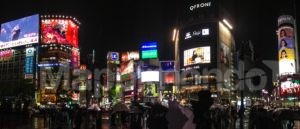
In my tour my first stop has to be the capital city.
While you are still on the airplane and are about to land you will be blinded by the city lights as you look out the window. It’s is enormous and so brightly lit that it looks like a gigantic Christmas tree, a shiny Eiffel Tower.
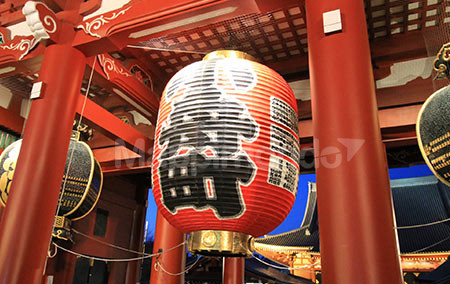
If you want to feel the “WOW” effect you really must arrive at night. Tokyo is Tokyo because of the skyscrapers brightened up by huge billboards, of the illuminated rice lanterns outside the restaurants and the subdued lights that illuminate the temples of Asakusa. This is the idea of Tokyo we get from films, from Japanese cartoons, from videos and adverts for Japan; and this needs to be your first impression.
Tokyo is a megalopolis, the Greater Tokyo Area counts 35 million inhabitants, that’s right! 35 million, that’s right!
There are two international airports in Tokyo: Narita and Haneda. Most international flights land in Narita, including our major airlines. Air China lands at Haneda airport, which is about 20 minutes by train from the centre of Tokyo. I booked the Air China flight using a flight comparison site, so I could order the flights based on price, duration and rating. Highly recommended! Be careful, though! Always check the duration, or you might end up with a 46-hour journey spending 30 hours goodness knows where. In any case, always check the websites of the different airlines, they might surprise you.

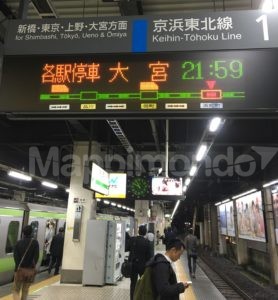
Train from the airport: After having dealt with the necessary bureaucracy and picked up your suitcase I suggest you take the train. Be careful, though, the writing is in Japanese; look carefully so you don’t get the direction wrong, but don’t worry, the wording in English will, sooner or later, appear. The names are really complicated and will give you a headache; take the Keikyu-kuko Line bound for Shinagawa then change for the green JY Yamanote Line bound for Tokyo Ueno. A bit stressful on the eyes!
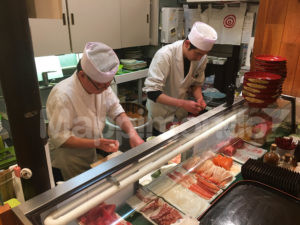
The hotel I chose is in CHIYODA, I’ve already described it under the hotel heading. It’s decent and, after all, having a room is what counts. It measures 12 square metres and it has everything; from a double bed to a Mazinga-style bathroom, where the toilet has more buttons than a cockpit.
It’s time for dinner and, despite the time zone difference, the thought of sushi or a yaki udon would revive even the dead.
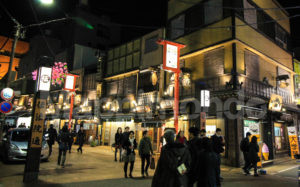
In Tokyo you immediately understand that the cheapest places, and also the best ones, are the ones the locals go to; the ones where you can forget to see a menu written in English and you are served by someone like Marrabbio in Kiss me Licia. The udons taste amazing. In Italy “Japanese cuisine” is now run by Chinese restaurants, who alter even their own cuisine to suit our tastes; there’s no way we can hope to eat real Japanese food!
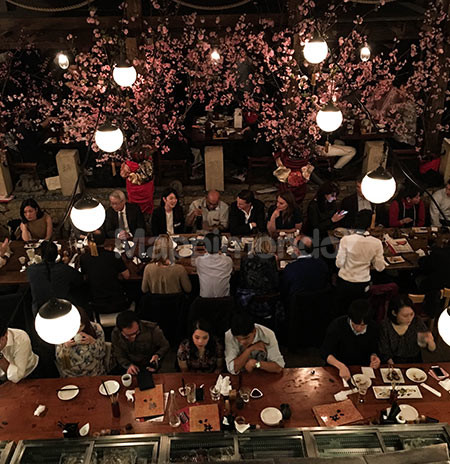
It’s nice to lose yourself in the evening walking through their streets, admiring their ideograms and the small restaurants with the red rice paper lanterns; but also to notice how they live, what they wear or simply observe how they walk.
The Japanese leave work really late, all men, dressed in a dark suit and white shirt and head for the clubs.
I’m starting to feel tired and it’s time to go back to the hotel for a well-deserved rest.
Compared to what we get in the West breakfast is not worth mentioning. We’re in the East here so you can forget our croissants, home-made cakes, or Neapolitan warm pastries in a three-star hotel. Which is why my first stop in the morning is Starbucks, which obviously has prices that are comparable to the legendary Florian in Venezia, with no Laguna in sight, however! You just have to accept it, you’re in Japan!
Tokyo in the morning gives me a totally different impression. Firstly, the bright skyscrapers with their incredible signs turn into grey blocks, which match the sky, also grey.
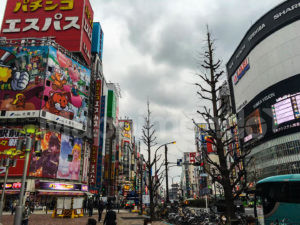
You don’t go to Tokyo for its ancient splendour; you’re not in Rome where every corner screams of history and you can breathe in its sophisticated beauty.
There’s nothing of the sort in Tokyo. You go to Tokyo for its modernity, because you want to see into the future, an automated and technological world, where you lift your eyes and find yourself surrounded by huge commercial billboards, by young girls wearing kimonos or the most eccentric clothes you can imagine.
You go there because the Shinkansen, and its 15-metre nose, is the train you cannot miss. You need to remain speechless when you see the designer skyscrapers of Ginza.
WHAT TO SEE IN TOKYO?
You immediately find out that the Japanese don’t only crowd our lovely cities but also their own to visit their monuments.
THE IMPERIAL PLACE
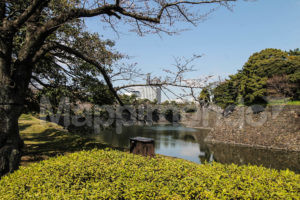
I decide that my first stop will be the palace of the Emperor of Japan, that is the man of divine origin, with no surname but an imposing name, the man who is at the head of the most ancient uninterrupted monarchy in the world.
If your hotel is in Chiyoda you can get there on foot. Visitors are only allowed two days a year and, alas, I wasn’t there on either of those days! You can only visit the gardens and the moat. Putting aside the stress of the checks you have to go through and the mandatory routes, the tour of the gardens didn’t impress me very much, even though the trees were in bloom. I could still remember the gardens of Versailles, which I had been to recently; and if I can’t even see the inside of this legendary palace, I must simply look at this as a nice morning walk to shake off the jetlag.
SHIBUYA
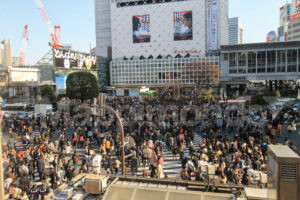
Dopo i giardini imperiali, mi dirigo a Shibuya (fermata metro Shibuya). A Tokyo è una tappa imperdibile per più ragioni:
After the imperial gardens I head for Shibuya (underground stop of Shibuya). Not to be missed for many reasons
1) It is the busiest junction in the world and, believe me, if you look at it from the Starbucks that is on the first floor of one of the buildings around the square you will see that when the lights go green everything comes to life for the pedestrians. A sea of people crosses from all sides simultaneously and onlookers, phones in hand, capture this moment. I’m no different. I’m there with my phone taking photos and videos, so be ready for it. I have no words to describe this junction if not that the crowd of people is absolutely amazing. The whole world is here! It gives you an idea of how many million people live in Tokyo. You are surrounded by so many people it’s like being outside the Stadium after a concert by Italian singer Vasco Rossi, or U2.
2) At Shibuya station you will see the statue of Hachiko, the dog that waited here every day for 11 years for his owner to arrive. A shame Richard Gere isn’t here, like in the film!
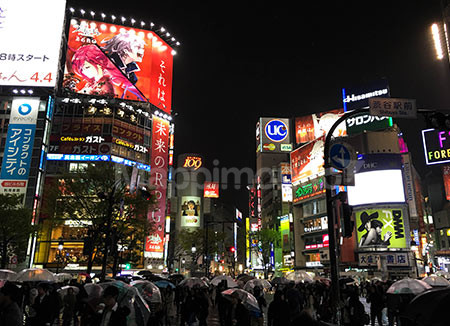
3) Here you’ll see the most incredible billboards. Come back at night and you’ll be enveloped by the lights.
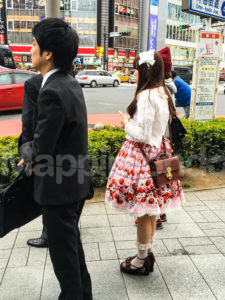
4) Trendy shopping neighbourhood: there’s up-market shopping at Omotesando; but here is where Harajuku Style was born, the Japanese manga style, where young girls create unusual mixes of extremely colourful clothes. The key words here are: mix and match. They remind me of Emma and Ginger from the Spice Girls. You’ll find young Lolitas, who look like gothic dolls; you’ll also see some dressed like their favourite cartoon characters. They are wearing layers of clothes; their hair is very colourful and in ponytails and they sport eye-catching accessories. They are a fantastic touch of colour in a fairly grey city.
It’s time for some nice sushi; the imperial gardens and Shibuya have made me hungry. You can go crazy in Shibuya, there’s all sorts.
I still haven’t told you about what happened on the underground. I decided to get a day pass, thinking it was like Rome or Paris, where you buy a daily ticket and have nothing more to worry about.
It has a grand total of 13 underground lines, managed by two different companies. The price also changes depending on distance. Basically, I paid for the daily pass and ended up changing onto a line run by the second company. However, this was not that clear and so I found I couldn’t get through the turnstile and didn’t know why. I’ve already said that finding someone who speaks to you in English is like looking for the lost ark with Harrison Ford. In the end a young and helpful girl explains that I have to buy another ticket as mine isn’t valid.
This underground debacle cost me around twenty euros!
Still, I’m in Tokyo. What more can I want?
ASAKUSA
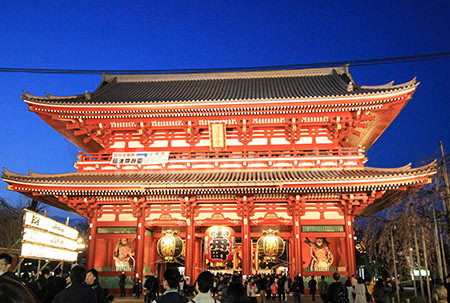
I continue my tour and explore the old Tokyo. More or less!
I’ve already said that there is nothing left of the old Tokyo, the ancient Edo. It was bombarded and rebuilt. So, Asakusa is a nice reproduction of what the city used to be like.
It’s the eastern part of Tokyo; during the Middle Ages it was considered the “low city” where the merchants and artisans lived.
This is where SENSO-JI, the most visited Buddhist temple in Tokyo is. You walk through a gate and find yourself in a pedestrian street full of all types of shops; you can get everything here, from kimonos for all pockets, to kokeshi dolls, from the varnished terracotta bowls the Japanese eat out of to the sake glasses, not to mention the famous geta, that is the wooden flip flops from the cartoons. Basically, I bought all sorts of stuff; I always buy like there’s no tomorrow.

Try the mochi, the typical small cakes filled with bean paste; I don’t actually like them much but you need to try them.
At the end of this road you’ll find the five-storey pagoda, which was faithfully rebuilt in 1973. There’s a censer in front of the temple and believers breathe in this incense, which is said to restore good health.
TOKYO SKY TREE
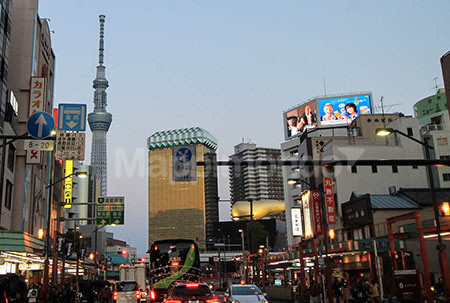
At 634m it is the tallest telecommunications tower in the world. You can climb to the top and admire the 360° view; try doing it at night so you can feel the magic of the city lights. It closes at 10pm.
In ROPPONGI and SHIBUYA there’s an incredible concentration of restaurants and clubs.
GONPACHI

Situated in Roppongi, this is the famous restaurant where they filmed the legendary scene with Uma Thurman and the katana in Tarantino’s Kill Bill 1. It’s gorgeous, in old Japanese style, with a 360° balcony and an open kitchen. You feel like you’re in the film; a bit Uma Thurman, without her body or face!
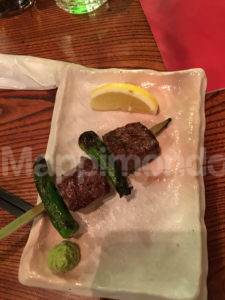 I read in the guide that the skewered kushiyaki are a must. Can I go without? Obviously not. I choose a meat one, the presentation is fantastic and it tastes delicious; but my goodness it’s tiny, just a taste of two small pieces of perfectly cut meat in between two mini vegetable squares. The Tempura arrives and it melts in my mouth. I order a Ramen, which is also lovely. I’m sitting at the counter in front of the kitchen and I admire the chef as he prepares a Tamagoyaki, the typical Japanese wrapped omelette; he’s so skilled and fast.
I read in the guide that the skewered kushiyaki are a must. Can I go without? Obviously not. I choose a meat one, the presentation is fantastic and it tastes delicious; but my goodness it’s tiny, just a taste of two small pieces of perfectly cut meat in between two mini vegetable squares. The Tempura arrives and it melts in my mouth. I order a Ramen, which is also lovely. I’m sitting at the counter in front of the kitchen and I admire the chef as he prepares a Tamagoyaki, the typical Japanese wrapped omelette; he’s so skilled and fast.
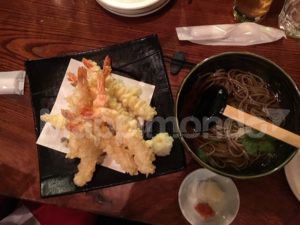
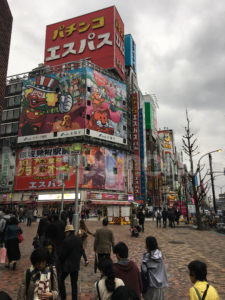 We continue our tour of Tokyo in the morning, destination Shinjuku, where you can find skyscrapers, the usual huge billboards and all types of electronics stores. In Shinjuku I lose myself in long walks; I am struck by the electric cables out in the open, sometimes we haven’t had for decades.
We continue our tour of Tokyo in the morning, destination Shinjuku, where you can find skyscrapers, the usual huge billboards and all types of electronics stores. In Shinjuku I lose myself in long walks; I am struck by the electric cables out in the open, sometimes we haven’t had for decades.
SHINJUKU-GYOEN
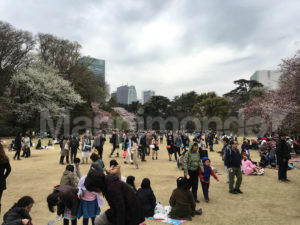
It’s Hanami season, where’s the best place to see the cherry blossoms flower? Shinjuku-Gyoen park. It used to be an imperial park, now open to everybody. Everyone tells me not to miss it when the cherry blossoms flower so that’s what I do. There’s a queue to get in and an entrance fee. Two things that make me think it’s spectacular. I don’t want to miss it. The cherry trees are in bloom and there are lots of Japanese people in kimonos ready to have their picture taken. It’s a nice park but I don’t think it’s that amazing!
As I leave the park, I head for Shinjuku station; they say it’s the busiest station in the world, why miss it?
GINZA
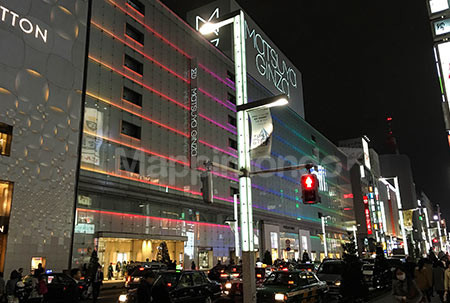
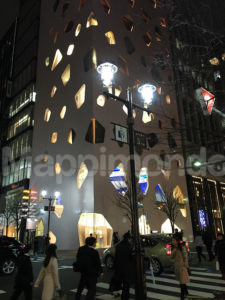
This is the place I keep going back to! The most luxurious neighbourhood in Tokyo, a Mecca for shopaholics of the highest level!
Extremely elegant, with skyscrapers illuminated by the world’s top designers: Gucci, Valentino, Dior, Armani and any others you can think of, as well as shopping centres. You don’t even need to tell an Italian not to buy there; no need to say the prices are inflated. Imagine Milan’s Via Montenapoleone and then transfer it all into amazing skyscrapers. Not to be missed!
Off to dinner, in the Ueno neighbourhood, at last!
It’s time to leave MAZINGA CITY and carry on travelling.
NARA
You arrive in Kyoto first and then change for Nara. Nara was Japan’s first capital so it deserves to be visited first. Go straight to NARA-KOEN, Nara’s park. It’s a wonder of nature with roughly 1,200 deer running around freely, happy to let tourists get up close to them. They are lovely. The Shinto religion used to consider them divine messengers, so sacred that anyone who killed one risked the death penalty; they are now protected animals.
Inside the park you can see the TODAI-JI, which means “the great oriental temple”, which houses the biggest wooden Buddha in the world, measuring 57 metres in height.
Nara is small, it doesn’t take long to visit.
KYOTO
Kyoto is the essence of Japan; I can say it’s the reason for my trip to Japan.
For over a thousand years it was the old capital of the Empire and, in my mind, it is the only one that still preserves a sense of what Japan once was. We are still talking about a fairly big city, with one and a half million inhabitants but, compared to Greater Tokyo’s 35 million, it seems very people friendly.
WHERE TO STAY IN KYOTO: Hotel prices in Kyoto are sky high and we go back to what I said before: it’s full of capsule hotels by the hour; I mean, as much as they may seem cool, I don’t want to be a capsule refugee. If possible, look for a Ryokan, but during the Hanami you’re lucky to find anything at all.
Let’s go to Gion and say no more!
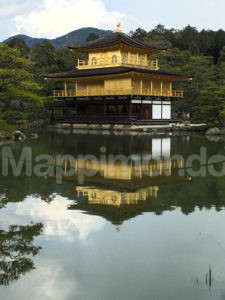 I decided to spend five days there as I not only want to visit the city, I want to savour it slowly. From Kyoto you can also go on daily excursion to places like Nara, Himeji castle and Osaka. I chose a small apartment on Airbnb; the first major problem is finding it! I enter the address into Google Maps, which makes me go round and round a number of streets; in the end I find this small door which gives me access to the apartment. I never actually saw the owner as he left me the passcode for the door and the key inside the letterbox. The apartment is very basic and clinical; it’s as far removed as possible from my way of conceiving an apartment, maybe because mine is really colourful and filled with objects from around the world and pictures and nice things that I like looking at. There’s also a kitchen in the bedroom and I see there’s a gas cooker and a fairly large saucepan: I’m overcome by an Italian actor Alberto Sordi-like desire for pasta. Ok, no sushi tonight, I’ll cook myself some spaghetti with something. I go down and head to the supermarket; I feel emotional when I find Barilla’s pesto sauce and buy it. My eyes light up as I make my way back imaging a steaming hot plate. I get back home and find out the gas is not actually connected. Oh well, sushi it is then!
I decided to spend five days there as I not only want to visit the city, I want to savour it slowly. From Kyoto you can also go on daily excursion to places like Nara, Himeji castle and Osaka. I chose a small apartment on Airbnb; the first major problem is finding it! I enter the address into Google Maps, which makes me go round and round a number of streets; in the end I find this small door which gives me access to the apartment. I never actually saw the owner as he left me the passcode for the door and the key inside the letterbox. The apartment is very basic and clinical; it’s as far removed as possible from my way of conceiving an apartment, maybe because mine is really colourful and filled with objects from around the world and pictures and nice things that I like looking at. There’s also a kitchen in the bedroom and I see there’s a gas cooker and a fairly large saucepan: I’m overcome by an Italian actor Alberto Sordi-like desire for pasta. Ok, no sushi tonight, I’ll cook myself some spaghetti with something. I go down and head to the supermarket; I feel emotional when I find Barilla’s pesto sauce and buy it. My eyes light up as I make my way back imaging a steaming hot plate. I get back home and find out the gas is not actually connected. Oh well, sushi it is then!
UNMISSABLE SIGHTS IN KYOTO:
GION: LOOKING FOR GEISHAS
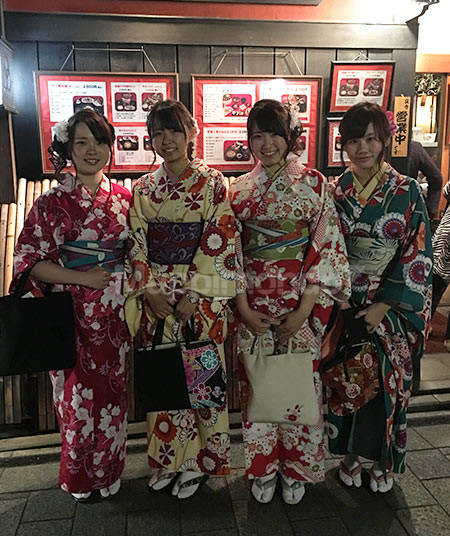
Before going to Kyoto, you can’t not find out more about geishas and what they are today.
The most likely time to meet them is in the afternoon, when they go out for the tea ritual. Gion is famous for its restaurants and tea rooms and, with its low wooden houses, it’s the most characteristic area in the whole of Kyoto. They filmed some of the scenes from “Memoirs of a Geisha” in Gion.
GEISHA means “Person of the Arts”. At the age of 15 the young maiko start their 5-year apprenticeship to become geishas, true and proper artists. They learn the ancient Kyoto dialect, traditional Japanese dances and to play the shamisen, a guitar with three strings.
You recognise a maiko because of the heavy make up on her face, a sort of white mask, the red on the lips and eyebrows, the flowers in her hair and the more elaborate kimono.
To be honest I saw two Geishas, the real ones I mean, and several maiko.
The rest of the city is throbbing with “fakes”; girls in their kimonos who pass the day at crowded tourist spots taking selfies and letting tourists take their pictures. A geisha doesn’t spend her time being photographed; from them you will get a stolen shot and not posed pictures.
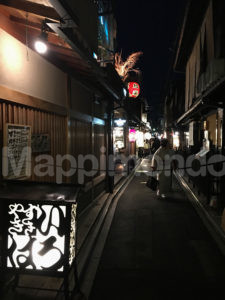
KINKAJU-JI: THE GOLDEN PAVILION

Residence of choice of shogun Ashikaga Yoshimitsu in 1397, it was coated with a sheet of gold. You can see its golden refection in the lake opposite it. It was burnt to cinders in 1950 and immediately totally rebuilt. It’s spectacular and a symbol of Japan.
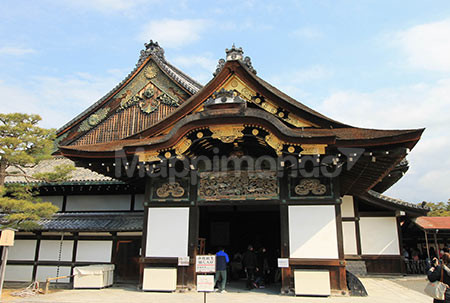
NIJO-JO
This is the SHOGUN CASTLE, complete with fortifications and bastions.
SHOGUN is the abbreviation of sei-i taishogun and means “great general of the force against the Barbarians”. This title is inherited and given to military dictators. They governed Japan from 1192 to 1868, the year in which the shogunate ended and power returned to the emperor.
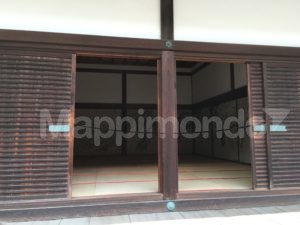 Inside you will find NINOMARU PALACE, which was used as an office and home by the shogun when he visited Kyoto. It consists of a number of different constructions which can be visited by going down corridors with squeaky floors. This was because the noise alerted them to the presence of an intruder, a disloyal subject. They are called “nightingale floors”.
Inside you will find NINOMARU PALACE, which was used as an office and home by the shogun when he visited Kyoto. It consists of a number of different constructions which can be visited by going down corridors with squeaky floors. This was because the noise alerted them to the presence of an intruder, a disloyal subject. They are called “nightingale floors”.
This is where I learn about the concept of the Tatami from the guide, as the floor is covered in tatamis WHAT IS A TATAMI? The tatami is everything in Japan; floor, bed, table, chair. Add a futon and it becomes a bed, take it off in the morning and move your tatami to create a new space. You can walk barefoot on the tatami. Homes are measured in tatamis, and we waste our time using metres; they have this sort of bed/floor/divider/table all-in-one. I summarised it in “Your life in tatamis”.
You can admire the beautiful painted screens and decorated ceilings. When you go on the tour you will go through several rooms in which they will explain that only a certain level of guest would get to see the shogun, who was seated on an elevated plane protected by bodyguards hiding in the wardrobes.
 KYOTO IMPERIAL PALACE:
KYOTO IMPERIAL PALACE:

This was the official residence of the Emperor up to 1868. It was built in 794, but, like everything in Japan, it was rebuilt several times due to fires as the structures are made of wood. You need a permit and a guide to visit it.
The garden is very well tended and the part that I think is worth seeing, with its paths and small lakes, even more than the palace itself.
By the way, I hired a guide for the whole day to see Kyoto and for the price I paid they should have also shown me Kyoto from space!
 FUSHIMI-INARI TAISHA
FUSHIMI-INARI TAISHA
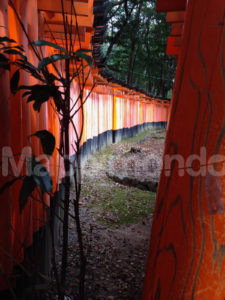
Maybe this is what has stuck in my mind the most. This Shinto complex is simply amazing. It is dedicated to Inari, the Shinto god of rice and sake. It is filled with statues of wolves as they were deemed to be the messengers of the god Inari.
WHAT ARE THE TORII? They are the gates to the Shinto shrine, the jinja. It seems they were introduced with the arrival of Buddhism. These gates allow you to pass from the real world to the spiritual one.
They are usually orange or red. Red is linked to the repression of demons.
Thousands of Torii stand one after the other along a route leading to the Inari-san sacred mountain. They have been donated by companies, but also individuals, who pay to see them displayed along the route and are inscribed with the name of the donator.
If you go when the sun is still up but almost time for it to set you will be able to enjoy the difference the changing light makes as the red grows increasingly intense.
BOSCO DI BAMBÙ DI ARASHIYAMA
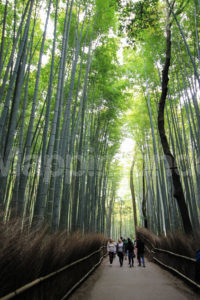
This is the legendary grove where you can “lose yourself” as you walk among the soaring bamboo stalks; so tall they almost block out the sky and envelop you with their green leaves.
I’d like to say you feel a sense of peace and quiet, but it’s very crowded. 
HIROSHIMA
Hiroshima is very authentic and it’s like being punched straight in the chest and bowled over.
Sadly, there is no need for introductions. It is one of the most symbolic places in the world. On 6 August 1945, Little Boy, the first atomic bomb, was launched by the US onto this quiet harbour town south of Honshu Island.
The first thing I saw was Genbaku Dome, the Atomic Bomb Dome. These are the remains of a 1915 building which was used as an Industrial Exhibition Centre and whose skeleton, incredibly, remained standing; an eternal testimony of this indescribable horror. It was declared a World Heritage Site by UNESCO in 1991.

You think back to the image of the atomic mushroom and the indescribable strength of the explosion which, in a few seconds, wiped away all forms of life and which has condemned survivors to a life of pain and illness.
From here you walk towards the Park of Peace, where there’s a small lake of Peace and where you feel indescribably calm, then you see the Cenotaph with the names of known victims and the Flame of Peace, which remains symbolically lit until the last nuclear weapon in the world is destroyed.
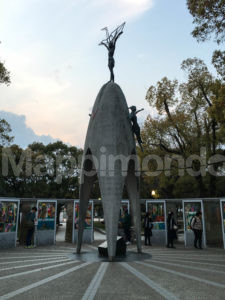
There’s also the Children’s Peace Memorial and you can feel a long shiver along your spine. It narrates a Japanese legend which says that if you make a thousand crane-shaped origami your wish will come true. Little Sasaki Sadako, who became ill with leukaemia when she was 11, started to make some but didn’t manage to finish her 1000 origami in time as death came and claimed her life. Her classmates finished the origami on her behalf. The Monument is dedicated to this innocent child and these origamis have become symbols of peace.
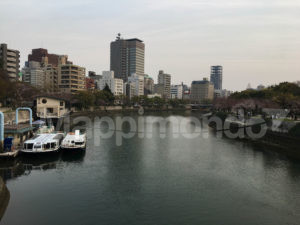
Hiroshima is the Phoenix that rises from its ashes, it’s a modern city, one that has managed to look ahead and carry on. Its streets are wide, clean, and full of shops, cinemas and restaurants.
Hiroshima is also the port from where you get the ferry, using the Japan Rail Pass to go to Miyajima.
MIYAJIMA
This island isn’t far from Hiroshima and can be reached by ferry. It is one of the most photographed places in Japan thanks to the iconic ISTUKUSHIMA-JINJA FLOATING RED TORII. When the tide is high it seems to re-emerge from the water.
The Istukushima shrine was built in 1168 and in the past it could only be reached by sea through the Torii, gateway to the Shrine which has been placed by the entrance to the bay.
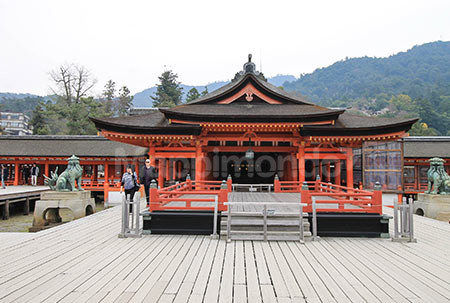
The island is full of deer roaming freely. According to Shintoists deer are sacred because they represent messengers from the gods.
I recommend you stay a night in Miyajima to enjoy the absolute silence and peace and quiet.


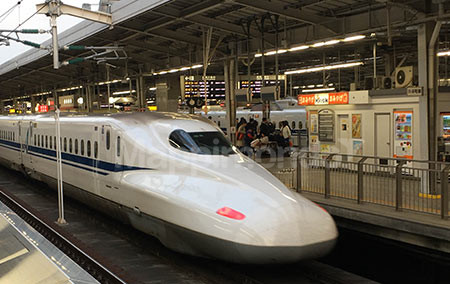
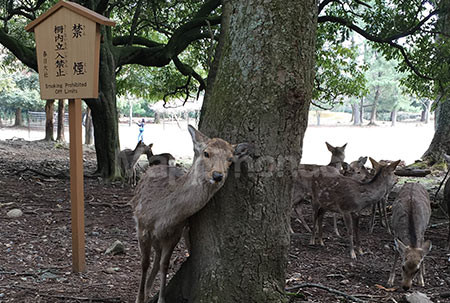
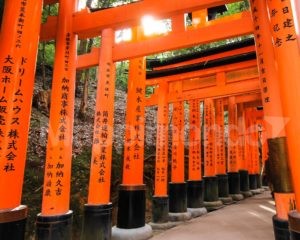
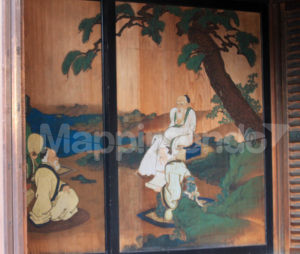 KYOTO IMPERIAL PALACE:
KYOTO IMPERIAL PALACE: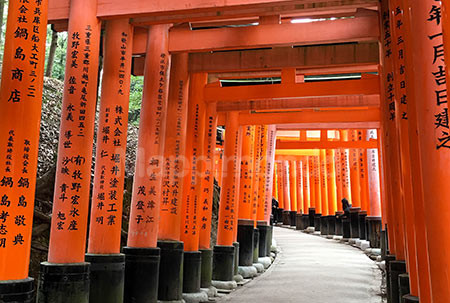 FUSHIMI-INARI TAISHA
FUSHIMI-INARI TAISHA





